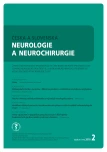Acute pediatric myelitis – cohort of 20 patients
Authors:
H. Nohejlová 1,2; P. Nytrová 3; Z. Libá 2
Authors‘ workplace:
Neurologická klinika 2. LF UK a FN Motol, Praha
1; Klinika dětské neurologie 2. LF UK a FN Motol, Praha
2; Neurologická klinika a Centrum klinických neurověd, 1. LF UK a VFN v Praze
3
Published in:
Cesk Slov Neurol N 2018; 81(2): 213-219
Category:
Short Communication
doi:
https://doi.org/10.14735/amcsnn2018213
Overview
Aim:
In this study, we focused on the current issue of pediatric myelitis and shared our clinical experience.
Patients and methods:
20 patients (10 girls, 10 boys; age 4– 17 years, median 14 years; follow-up period 1– 73 months, median 15 months) with acute spinal syndrome and without encephalopathy; acute spinal compression was excluded and inflammatory etiology was considered. Analysis of clinical and para-clinical data (magnetic resonance imaging [MRI] of the brain and spinal cord, cerebrospinal fluid examination, microbiological and immunological testing, serum aquaporin 4 antibodies). We evaluated the clinical course, response to acute therapy and the final diagnosis; whether the current international diagnostic criteria were fulfilled for clinically isolated syndrome (CIS), pediatric multiple sclerosis (MS) or neuromyelitis optica spectrum disorders (NMOSD).
Results:
One patient had infectious Borrelia-related myelitis. Acute myelitis as a symptom of CIS/ MS was in eight cases and as a symptom of NMOSD in three cases. Idiopathic myelitis was diagnosed in eight children. CIS/ MS patients in comparison to NMOSD patients had different clinical courses, laboratory findings and responses to acute therapy. The most serious were patients with idiopathic myelitis – with rapid progression of spinal symptoms and extensive spinal lesions detected using MRI of spinal cord. They had poor response to corticotherapy. Some of these patients were successfully treated with combined immunosuppression.
Conclusions:
Acute myelitis is a complicated diagnosis, which requires a comprehensive approach and clinical experience.
Key words:
pediatric myelitis – neuromyelitis optica – multiple sclerosis – acute therapy
The authors declare they have no potential conflicts of interest concerning drugs, products, or services used in the study.
The Editorial Board declares that the manuscript met the ICMJE “uniform requirements” for biomedical papers.
Sources
1. Wolf VL, Lupo PJ, Lotze TE. Pediatric acute transverse myelitis overview and differential diagnosis. J Child Neurol 2012; 27(11): 1426– 1436. doi: 10.1177/ 088307381245 2916.
2. Transverse Myelitis Consortium Working Group. Proposed diagnostic criteria and nosology of acute transverse myelitis. Neurology 2002; 59(4): 499– 505.
3. Irani DN. Aseptic meningitis and viral myelitis. Neurologic Clinics 2008; 26(3): 635– 655. doi: 10.1016/ j.ncl.2008.03.003.
4. Deiva K, Absoud M, Hemingway C et al. Acute idiopathic transverse myelitis in children: early predictors of relapse and disability. Neurology 2015; 84(4): 341– 349. doi: 10.1212/ WNL.0000000000001179.
5. Rostasy K, Bajer-Kornek B, Venkateswaran S et al. Differential diagnosis and evaluation in pediatric inflammatory demyelinating disorders. Neurology 2016; 87(9): S28– S37. doi: 10.1212/ WNL.0000000000002878.
6. Tardieu M, Banwell B, Wolinsky JS et al. Consensus definitions for pediatric MS and other demyelinating disorders in childhood. Neurology 2016; 87(9): S8– S11. doi: 10.1212/ WNL.0000000000002877.
7. Winderchuk DM, Banwell B, Bennett JL et al. International consensus diagnostic criteria for neuromyelitis optica spectrum disorders. Neurology 2015; 85(2): 177– 189. doi: 10.1212/ WNL.0000000000001729.
8. Polman CH, Reingold SC, Banwell B et al. Diagnostic criteria for multiple sclerosis: 2010 revisions to the McDonald criteria. Ann Neurol 2011; 69(2): 292– 302. doi: 10.1002/ ana.22366.
9. Vargas MI, Gariani J, Sztajzel R et al. Spinal cord ischemia: practical imaging tips, pearls, and pitfalls AJNR Am J Neuroradiol 2015; 36(5): 825– 830. doi:10.3174/ ajnr.A4118.
10. Absoud M, Greenberg BM, Lim M et al. Pediatric transverse myelitis. Neurology 2016; 87(9): S46– S52. doi: 10.1212/ WNL.0000000000002820.
11. Tobin WO, Weinshenker BG, Lucchinetti CF. Longitudinally extensive transverse myelitis. Curr Opin Neurol 2014; 27(3): 279– 289. doi: 10.1097/ WCO.0000000000000093.
12. Tenembaum S, Chitnis S, Nakashima I et al. Neuromyelitis optica spectrum disorders in children and adolescents. Neurology 2016; 87(9): S59– S66. doi: 10.1212/ WNL.0000000000002824.
13. Havrdová E, Piťha J. Klinický standard pro diagnostiku a léčbu roztroušené sklerózy a neuromyelitis optica. Praha: Národní referenční centrum 2012. Dostupné z URL: http:/ / www.czech-neuro.cz/ archiv/ data/ q/ O/ V/ 0031-rs-odborna.pdf.
14. Flanagan EP, Weinshenker BG, Krecke KN et al. Short myelitis lesions in aquaporin-4-IgG– positive neuromyelitis optica spectrum disorders. JAMA Neurol 2015; 72(1): 81– 87. doi: 10.1001/ jamaneurol.2014.2137.
15. Sorte DE, Poretti A, Newsome SD et al. Longitudinally extensive myelopathy in children. Pediatr Radiol 2015; 45(2): 244– 257. doi: 10.1007/ s00247-014-3225-4.
Labels
Paediatric neurology Neurosurgery NeurologyArticle was published in
Czech and Slovak Neurology and Neurosurgery

2018 Issue 2
- Metamizole vs. Tramadol in Postoperative Analgesia
- Memantine in Dementia Therapy – Current Findings and Possible Future Applications
- Memantine Eases Daily Life for Patients and Caregivers
- Metamizole at a Glance and in Practice – Effective Non-Opioid Analgesic for All Ages
- Advances in the Treatment of Myasthenia Gravis on the Horizon
Most read in this issue
- Ataxia
- Brain biopsy in 10 key points – what can a neurologist expect from the neurosurgeon and the neuropathologist?
- Fabry disease, an overview and the most common neurological manifestations
- Glucose transporter-1 deficiency syndrome – expanding the clinical spectrum of a treatable disorder
